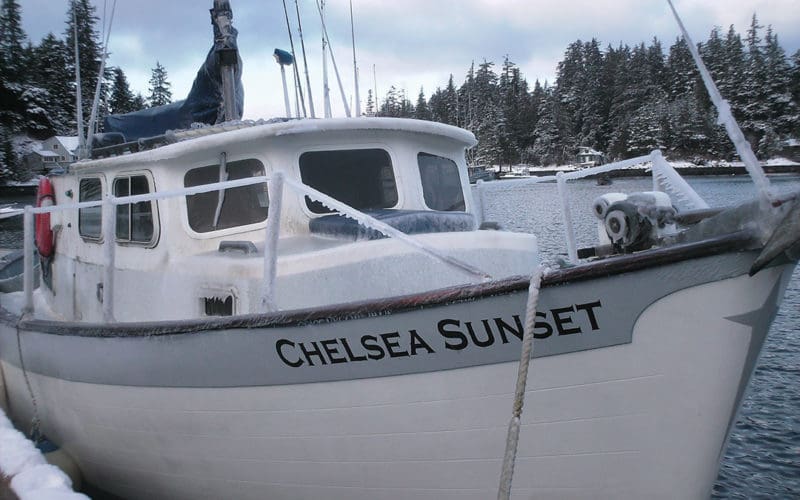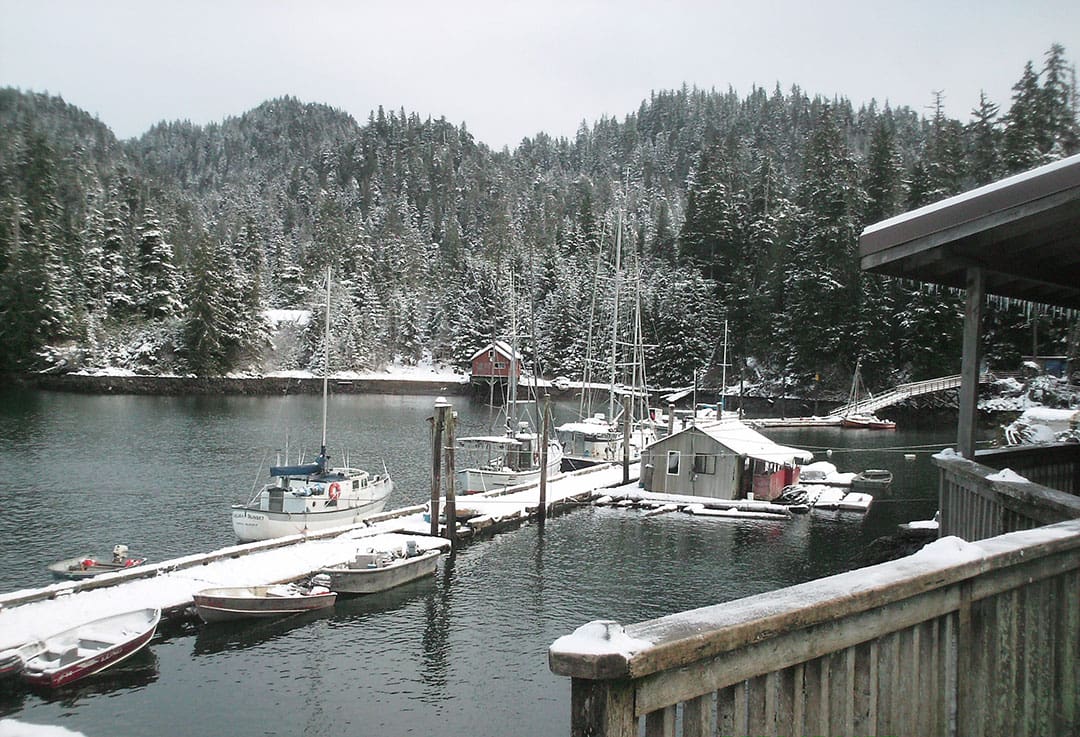
A captain recounts his first paid passage in the dead of the Alaskan winter
The engine quit, in the worst of all places at the worst of all times.
I experienced that moment a long time ago, but I have thought of it often. It was 2009 and I had just quit my job in law enforcement and was set on becoming a professional sailor. Working part time as a boat broker opened the initial doors to boat delivery contracts. These entry-level opportunities were somewhere between leftover and rotten fruit, and this particular peach of an opportunity was a 30-foot Willard Vega 30 named Chelsea Sunset.

I was asked for a quote for her immediate delivery from Klawock, Alaska to Juneau, a trip of about 250 nautical miles that included an outside stretch in the North Pacific Ocean. It was January. My initial bid was rejected and I received a counter offer for half as much. I had no argument and even less resume to boost my dollar value, and I was driven enough to move that old tub to Juneau in winter for peanuts.
“I’ll do it,” I burst out during the phone call with the owner. A few days later, in early January, I was disembarking the Prince of Wales ferry to climb into a very expensive taxi cab with my rain gear, survival suit and a box of McGuyver solutions that came to be my delivery kit in the future.
My start in the sailing world, Empiricus, a 50-foot yawl that I had purchased three years earlier, had been my classroom for learning about sailing, boathandling, boat repair and everything else that goes into running a boat. I had her quirks worked out, drinking steadily from the fire hose of learning that comes with single-handed sailing in Alaska waters. But this Willard Vega was a whole new boat.
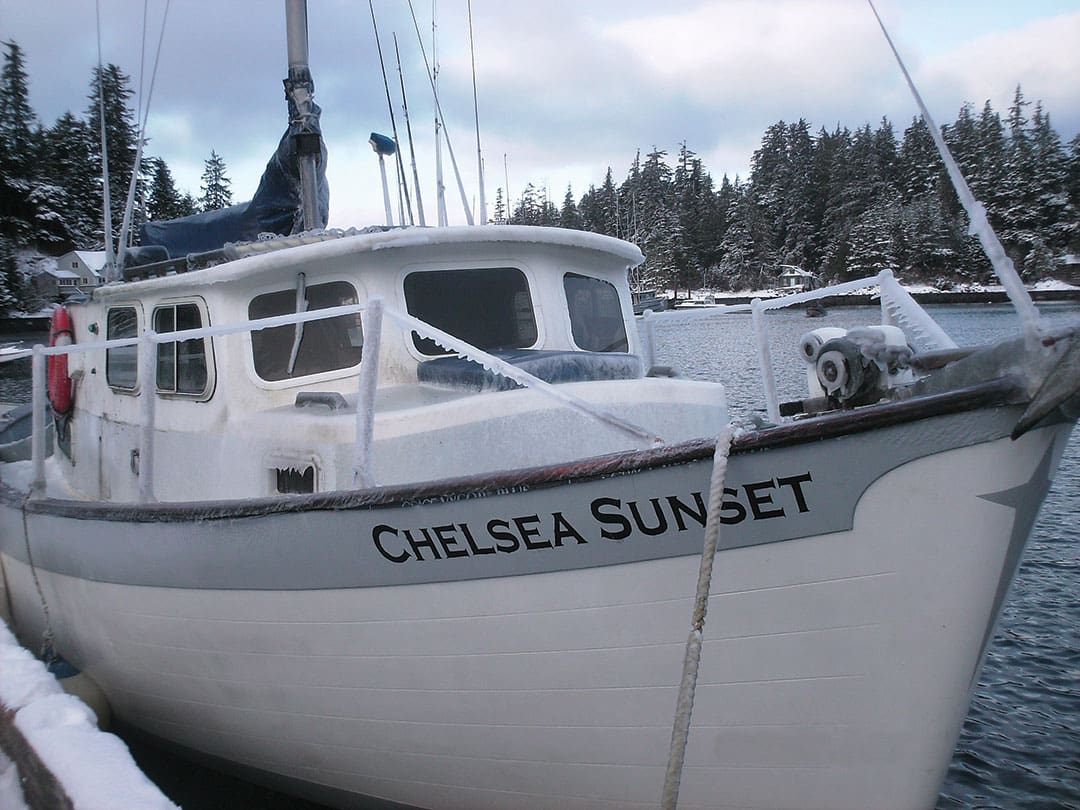
The wet wind blew down my neck as I dragged my gear down the dark, quiet dock through heavy, rain-soaked snow. I had a picture of the boat and could just make out her name wrapped across her wide stern under a brim of snow. She sagged like a dripping ice-cream sundae. Digging snow from the cockpit with my hands and thawing the lock with heavy slow breaths, I made a mental note to add a shovel to my delivery kit. Inside, the boat was cold and damp.
Charging the batteries
I dropped my gear, powered up the radio and got to work preparing for the voyage. The weather channel crackled away, robotically announcing a frigid forecast. I checked the oil, opened the seacock (already open), started the engine and charged the batteries up for a few minutes. I let her run for a while, just to make sure there was no air in the fuel system. Then I just listened. Other than being slow to crank and start, the engine ran fine at elevated rpm and idle. The fuel tanks looked like hell, but I had a pile of extra filters with me, having already learned that lesson.
I had some training in mind to do right at the dock, and so set about it by going to the secondary fuel filter/water separator (the engine mounted filter is technically the primary). I opened the housing to let air in. At idle, it takes a few minutes to empty the line and filter housings of fuel before the engine stalls and quits. Every engine has a similar thrum when losing prime. This Perkins gave a few hisses and a lope, then one big gasping spin before dying. Unmistakable, once you have heard it.
I pressed the button on my stop watch, grabbed my tool bag and began basic diesel engine CPR. Where is the bleeder screw? And the fuel lines — where do they run? Can I reach the manual prime paddle on the lift pump? I grunted, gandered, and gathered my tools. Soon enough I had the right wrenches in the right places. The lines were wet to the injector pump with a nut cracked at the end of the line. I hit the starter. She wound up and began to pop but I let off too soon. The second crank session was concerningly slow, the weak batteries showing, but she fired off at last. I pulled my filthy cuff back and stopped the watch at a little more than five minutes. Too slow. I ran the drill until I could prime the system and fire the engine in about 40 seconds.
The rest of the night was spent peering over paper charts and doing battle with the Dickenson stove. I only had a white belt in Dickenson stoves and this one was beating me up. The fuel system for the engine and the heater were combined, a key problem I would sort out later.
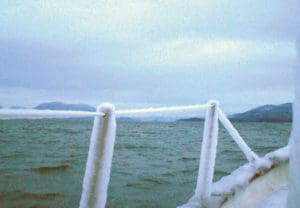
I crawled into my sleeping bag and fell asleep to the sound of ice chunks falling from the pilot house to the deck and the steady drip of melting snow.
Morning came on January 5 with the winds calm and the decks clear of snow. I fired up the engine, kicked the lines and tried to depart, but could not engage forward gear. Had to tie up again and fix the jammed transmission cable. By 0830 I was off the dock and by 1030 was fueled up from the Craig fuel dock, with five more filters on board for good measure. The goal for this first leg was Port Protection, roughly 80 nautical miles north.
The fat little Vega proved bombproof, but that first night I tasted fear. Due to my ignorance, the higher winds and heavy seas on the open edge of the Gulf of Alaska surprised me. Freezing spray began building on the foredeck and pilothouse in a heavy, gray rime. The lee helm from the jib became too much to hold a course so I shimmied around the icy pilot house to douse it.
Dropping the jib into the water
Never was my inexperience so clear as when striking the little jib while motoring in circles (there was no autopilot). The sail dropped into the water and I had to work hard to recover it. Eventually, after skating in circles on the foredeck, I had the jib tamed. I crammed it down below, sheets and all, took the helm and turned back north.
The ride was much worse with no sail but at least I could see forward of the bow, and the lee helm was gone. The main was a shambles, but I was not handy enough to make something of it. I motored on, through the black, howling night, gnawing at my lip but glad to be inside the pilothouse.
As I entered Sumner Straight, the sea laid down. I noticed the cabin was very hot. I turned from the helm and saw the Dickenson stove, cherry red from deck fitting to legs, almost translucent, like hot taffy. Hot, melting taffy. The temp gauge was pegged at over 700 deg F.
I shut the fuel off to the stove and watched it like a hawk over my shoulder until it was no longer glowing. The cabin became cold within the hour and I took to thawing the pilothouse window with my camp stove.
It was 12:30 two days later by the time I made Port Protection. That watch was finished with a leap to the dock with a stern line, as reverse failed to engage.
I tucked into my bag as the temperature dropped to the teens, quiet and crisp. I was exhausted and frozen, but not willing to trust the Dickenson again while I slept.
I stayed that day and another night, making more thorough repairs to the shift cables and a few other things that shook loose during the passage, including a full cleaning and re-assembly of the Dickenson stove carburetor, assuming a stuck needle had allowed fuel to free flow to the burner. I replaced the secondary fuel filter again, as all the rough seas had churned up sludge in the tank.
Shared fuel lines
As I test ran the Dickenson, I learned that the shared fuel lines were a real problem. Sometimes the engine and stove were fine running together. Then sometimes one of them would suffer a flow disruption and quit.
I decided that the air to the engine was coming backwards through the carburetor on the stove. My plan was to shut the Dickenson off completely. As the engine was in the pilothouse, I would simply remove the floorboard over the engine and straddle the hole, letting the heat from the engine warm the cabin passively. This worked well enough. I used my camp stove again to thaw the thick ice from the windshield from time to time.
January 9th at 9:00 I departed Port Protection and proceeded with my no-heat plan. It was cold and relatively calm when I departed. By 17:00 I was anchored in Saint Johns Bay and took the following notes:
“Today was a test. A test of skill, courage, strength and wit. Where do I start? Confused seas and a 25-knot headwind made slow going. Freezing spray made two inches of ice on the foredeck. Water in the bilge got the alternator belt wet and almost burned it up from squealing. Rubber smoke filled the pilothouse and I was adrift to solve the problem. This trip reminds my why I do not own a Dickenson stove. It quit midway and the windshield froze ½-inch thick. The wiper is broken. I had my head out the window to find nav marks. Heaving seas at Saint Johns made for a rough dark entrance. The windlass was caked in three inches of smooth hard ice and the chain froze in the locker. It took 20 minutes of smashing the chain bight with a pipe to free the mess one link at a time. I smashed the chain with the pipe, anchor dangling until I drifted toward rocks. Then motored to the middle again for another session. Each time climbing the rails around the pilothouse, all caked in ice.
“Once the anchor was down, I revived the Dickenson, ate a hot meal, then smashed ice off the boat with the pipe for 90 minutes straight. To Do: Replace belt, new fuel filter, clean up.”
The next morning I noted the following in the log: “01/09/09 0800 Pulling anchor, headed to the narrows. No heater. Engine floorboard removed for heat.” The narrows I wrote of were the Wrangell Narrows, a 22-mile slalom through 60 navigation aides, with currents to seven knots that ebb and flow from each end simultaneously. It is a tricky piece of water for an under-powered boat. This would be my second time through, but the first time alone, so I planned to transit in daylight.
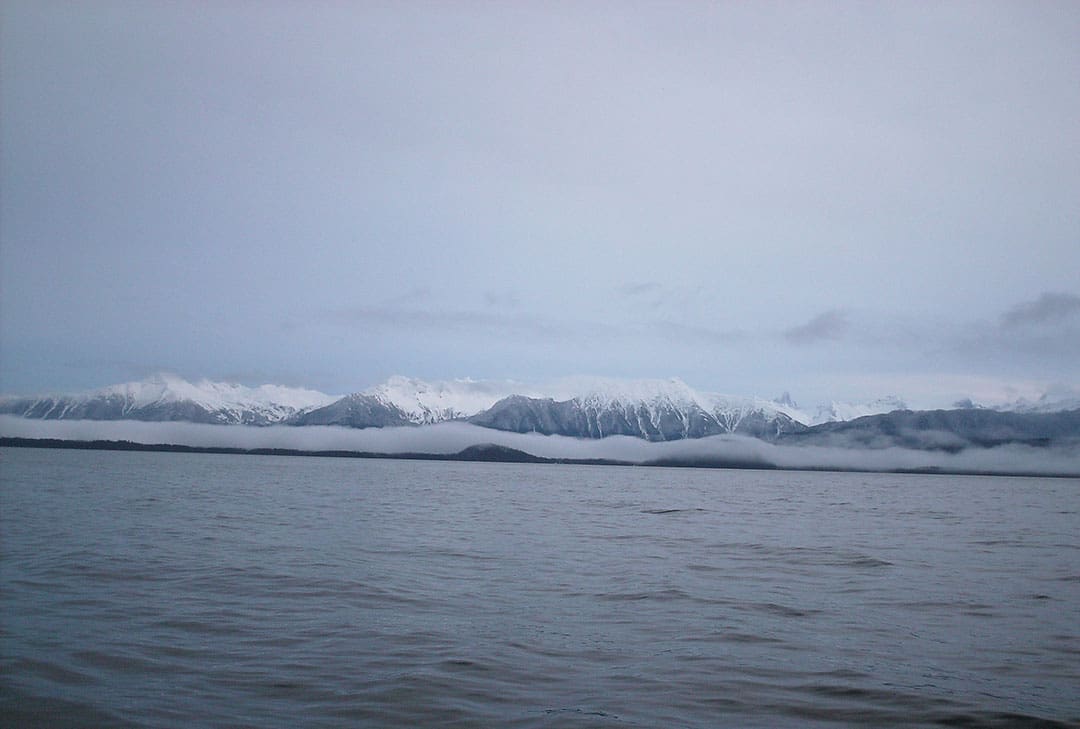
Good timing
My timing for the narrows was smack on the money — I rode the last of the flood in to the south entrance. It began snowing goose feathers, stacking up on deck, and in slushy flows on the water. All was quiet. Chelsea Sunset purred on, pushing snow, and I drank coffee, feeling proud of my work.
At 11:30 I had a problem. Not a boat problem, but a personal one. I had to go. Not number one. The other one. We all know this problem. The timing was so very, very bad.
Threading that tricky, now snowy channel with only manual controls, and dozens of channel marks ahead, I could not leave the helm. Not for even a few seconds. Even the slack water swirls around your hull in the narrows. I was glued to this helm until the passage was complete. I held on until the last minute, the last possible second, but with hours looming ahead, there was no option. I reached for the garbage can.
So there I was, one leg over the engine, in a bent knees position familiar to all. I had my eyes on the channel, one hand on the can, the other hand on the helm, steering close by a day mark when I heard it. Unmistakable.
Thrum. Thrummm. Thhhrrrrummm…clunk. The engine quit, in the worst of all places at the worst of all times.
Springing into action
My next moments felt like a three stooges act, where I played all three at once. Stowing the can, I fumbled at my pants while aiming the boat for the shallows, near some trees on the port side. She began to spin slowly in the back eddy. The current was changing fast and the snow boiled and heaved around the boat.
It took all my self restraint not to turn that key. I knew the batteries were weak. A vision ran through my mind of anchoring, but shoal water in a dropping tide nixed the idea. I didn’t want to let go the wheel to prime the system. Desperation hardened my throat as I imagined laughable options — was there a paddle on board? But the only answer was to prime.
Three deep breaths, and I sprawled onto the engine. Shadows of branches and landscape spun in the wheelhouse windows. I set to work bleeding the fuel system. I was fast after my practice. Thirty agonizing seconds later, I had one hand on the key and the other on my bleeder wrench. With closed eyes, praying, I twisted each hand for the final step.
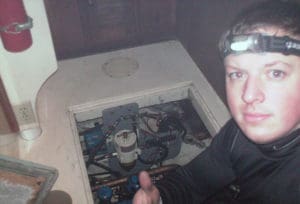
One slow slump of the engine. This was it. I held the key hard to start. It slumped again. I dropped the wrench and grabbed the radio, a Mayday call at the ready. Starter be dammed, let it burn up. I held the key. She slumped. Then bumped. Then…popped. I dropped the radio, grabbed the injector nut and spun it all the way. She popped again and fired off. She was alive!
The open injector line sprayed my still-bare legs with pulses of diesel while I straightened out the helm with the throttle wide open. I seated the injector nut, deafening myself with whooping and hooting! It finally was fixed because I ran the rest of the way through the narrows without a hitch.
On January 10, having made more repairs in Petersburg, including eliminating the heater from the fuel system, I was flying balanced canvas downwind through Fredrick Sound in heavy snow, with no issues.
The next day at 16:45 I entered a snow-buried Juneau Harbor and rammed the bow of Chelsea Sunset no less than three times in and out of the first visible slip in the harbor. Her hull wedged the snow aside with each stab until I finally stepped off into three feet of heavy wet snow. There was no need for a dock line, and no visible cleat to tie to in any case. The boat in the next slip was sunken, with only half the rigging visible, but that’s another story.
I tied her up securely later on, and collected my fee. My first paid sailing trip!
Though the delivery of Chelsea Sunset was not a glorious representation of seamanship, that delivery marked the end of a dream and the beginning of its actualization. I knew for certain, on that snowy dock, that I would sail for a living. n
Jesse Osborn owns Seven Seas Sailing Logistics, which provides captain services, consulting, teaching and project management for sailboats.

